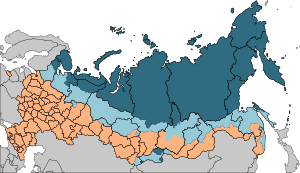
Back شمال روسيا Arabic Алыҫ Төньяҡ Bashkir Крайняя Поўнач Byelorussian Крайняя Поўнач BE-X-OLD Rússia del nord Catalan Dálný sever Czech Άπω Βορράς (Ρωσία) Greek Ekstrema Nordo (Rusio) Esperanto Extremo Norte ruso Spanish Kaug-Põhi Estonian
This article has multiple issues. Please help improve it or discuss these issues on the talk page. (Learn how and when to remove these messages)
|

The Extreme North[a] or the Far North[b] is a large part of Russia located mainly north of the Arctic Circle and boasting enormous mineral and natural resources. Its total area is about 5,500,000 square kilometres (2,100,000 sq mi), comprising about one-third of Russia's total area.[1] Formally, the regions of the Extreme North comprise the whole of Chukotka Autonomous Okrug, Kamchatka Krai, Magadan Oblast, Murmansk Oblast and Sakha, as well as certain parts and cities of Arkhangelsk Oblast, Irkutsk Oblast, Khabarovsk Krai, Komi Republic, Krasnoyarsk Krai, Republic of Karelia, Sakhalin Oblast, Tuva, Tyumen Oblast, as well as all islands of the Arctic Ocean, its seas, the Bering Sea, and the Sea of Okhotsk.
Due to the remoteness and the harsh conditions of the area, since the Soviet times people who work there have traditionally been entitled by the Russian government to higher wages and many other benefits,[2] including earlier retirement age,[3] than workers of other regions.[4] As a result of the climate and environment, the indigenous peoples of the area have developed certain genetic differences that allow them to better cope with the region's environment, as do their cultures.[5]

In 2012, the photoreporter Justin Jin released an award-winning photodocumentary Zone of Absolute Discomfort about gas extraction in Russian Arctic.[6]
Cite error: There are <ref group=lower-alpha> tags or {{efn}} templates on this page, but the references will not show without a {{reflist|group=lower-alpha}} template or {{notelist}} template (see the help page).
- ^ Laverov, Nicolay (2009). Area Studies (Regional Sustainable Development Review): Russia - Volume I. EOLSS Publications. p. 87. ISBN 9781848260740. Retrieved 22 October 2016.
- ^ "pochemu_rabotat_na_kraynem_severe_vygodno". объясняем.рф.
- ^ "Портал государственных услуг Российской Федерации (Why is it profitable to work in the Far North?)". www.gosuslugi.ru. Retrieved 2024-02-19.
- ^ Saunders, Robert; Strukov, Vlad (2010). Historical Dictionary of the Russian Federation. Scarecrow Press. p. 179. ISBN 9780810874602. Retrieved 22 October 2016.
- ^ Yenikeev, Alexander. "Poles Apart". getrussia.com. Retrieved 4 November 2016.
- ^ Justin Jin, The workers searching for gas in the icy Russian Arctic – a photo essay, The Guardian, February 28, 2022